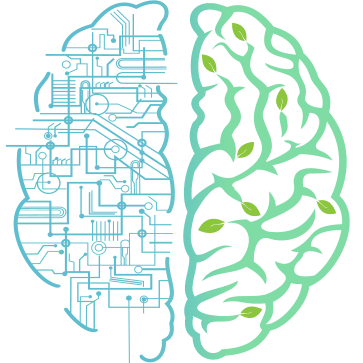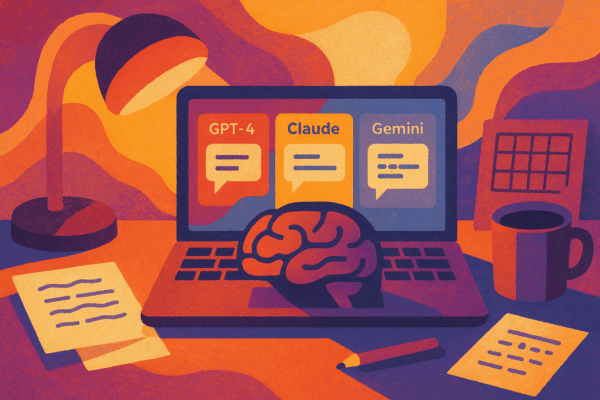Some mornings, our minds feel like a cluttered desk — scattered notes, half-done tasks, and a to-do list that hums in the background like white noise.
Then something remarkable happens. You open your laptop, type a few prompts into an AI model, and within seconds, the fog lifts. You have structure, clarity, and — perhaps most surprisingly — a strange feeling of relief.
This, right here, is the quiet power of cognitive offloading: the psychological act of transferring mental tasks to external tools. It’s the same feeling as writing in a planner — except this planner thinks back.
It’s why more and more of us are comparing AI models for productivity. We’re not just looking for clever code — we’re looking for peace, progress, and a sense of being less overwhelmed.
But can these models truly support us, or are they slowly becoming substitutes for the very things that make our work meaningful?
The New Desk Mate: Language Models as Productivity Companions
There’s a Danish word, arbejdsglæde — the joy of work. Not the paycheck, not the promotion, but the deep satisfaction of flow, purpose, and presence.
The best AI models don’t remove that joy. They make space for it.
When you use a model like GPT-4 to brainstorm ideas or Claude 3 to untangle complex writing, it feels like a thought partner — not a replacement. You stay in the driver’s seat, but now, someone’s reading the map for you.
In fact, psychologists say that mental clarity boosts intrinsic motivation. When our thoughts feel less scattered, we become more willing to tackle difficult tasks. That’s what these tools promise — not shortcuts, but momentum.
And it’s one reason so many people are, again, comparing AI models for productivity. Because we don’t just want to work harder — we want to work better.
The Double-Edged Sword of Digital Support
But every tool casts a shadow.
\In a recent 2025 study published in Behavioral Sciences, researchers confirmed what many already feel: AI can either empower or erode. It depends on how it’s used.
Here’s the catch: when AI starts taking over core task characteristics — like making decisions, crafting meaning, or reducing autonomy — it can trigger something known as work alienation. Psychologically, that’s when people stop seeing themselves in their work. They feel replaced, redundant, or disconnected.
It’s a modern twist on an old idea: if we lean on machines too much, we risk outsourcing part of ourselves. What once helped us step our game up might quietly be stepping in to take over.
One especially intriguing psychological principle here is the Zeigarnik Effect — our minds naturally want to finish incomplete tasks. But when AI tools finish them for us, we lose the closure our brains crave. It’s like skipping the last page of a journal entry, or never getting to jot down the idea that came to us mid-shower. Efficient, yes — but emotionally incomplete.
Comparing AI Models for Productivity: What to Look For
So how do we choose the right companion?
Let’s explore some of the most popular models, not just as tech, but as extensions of our thinking — each offering a different way to free up time, preserve focus, and keep on top of things without sacrificing creativity.
1. GPT-4 (OpenAI)
Curious, creative, and empathetic. Great for writing, ideation, and deep conversations. Feels like a co-author who really listens. It’s the best choice if your work is idea-heavy and emotional in tone.
2. Claude 3 (Anthropic)
A philosopher in a digital body. Calm, precise, and structured. Ideal for summarizing dense materials or reflecting on nuanced topics. Great for introspection and structured clarity.
3. Gemini (Google)
If productivity is your daily battlefield — emails, meetings, reminders — Gemini thrives in chaos. Its native integration with Google Workspace makes it more assistant than analyst. You can lean on it to juggle tasks and stay in sync.
4. Mistral, Mixtral, and Open-Source Models
Fast, focused, and logic-driven. These are often favorites for coding, automation, and technical users who want raw speed and minimal fluff.
There’s no one-size-fits-all solution — only what aligns with how your mind works. That’s why comparing AI models for productivity isn’t just a tech question — it’s a personal one
Psychology of the Productive Mind: More Than Just To-Do Lists
Consider this: one of the greatest drains on focus isn’t the work itself — it’s decision fatigue.
By the end of a long day, our brains have spent so much energy choosing and switching tasks that they default to easier behaviors: distractions, procrastination, avoidance.
AI models can counteract this. They help free up cognitive space by organizing notes, summarizing content, or even suggesting next steps — which makes it easier to jot down what matters and stay present.
Ultimately, the right AI companion doesn’t just help you get more done — it helps you step your game up in a way that feels sustainable and human.
The Opportunity (and the Quiet Warning)
AI can open new doors. It can be a mapmaker — not the destination or the vehicle, but the tool that makes the journey smoother. It helps creatives stay on top of things, frees thinkers to explore, and supports those looking to grow their ideas into action.
Still, the quiet warning remains: don’t forget who’s driving.
That’s why comparing AI models for productivity is more than a technical comparison — it’s a reflection on how we want to think, work, and live.






